Financial Analysis of BHP Billiton: Managerial Finance Report 2019
VerifiedAdded on 2023/01/04
|15
|4150
|40
Report
AI Summary
This report provides a comprehensive financial analysis of BHP Billiton, a major player in the mining industry. It begins with an executive summary and introduction, followed by a detailed examination of the company's risk profile, including systematic and unsystematic risks. The report assesses BHP Billiton's financial performance using financial statements and ratio analysis, covering profitability, efficiency, and liquidity ratios. Additionally, it explores the time value of money, the company's finance and dividend payout policies. The analysis includes a review of the company's operational review and production targets. The report concludes with a summary of key findings and references to support the analysis.
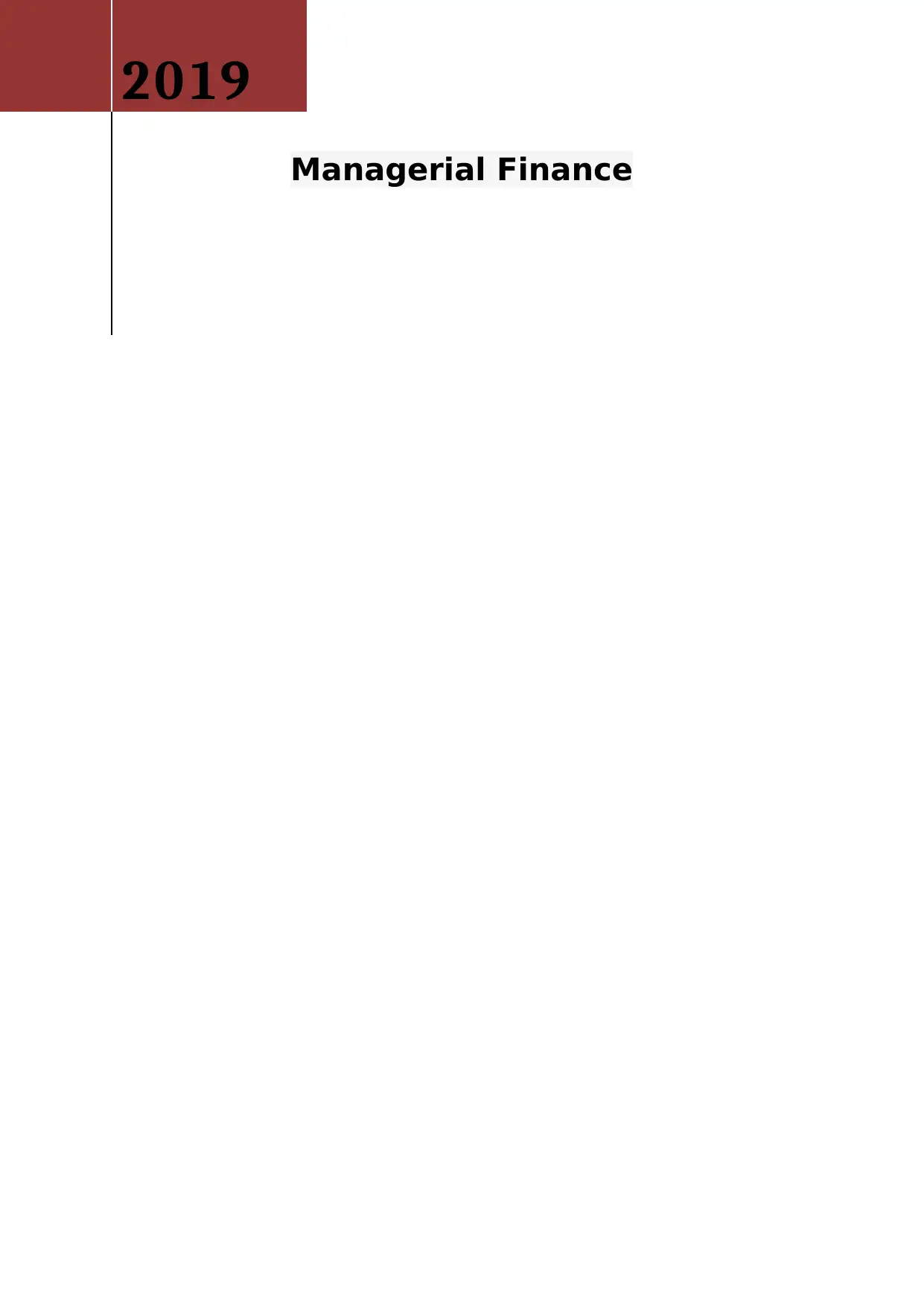
Managerial Finance
2019
2019
Paraphrase This Document
Need a fresh take? Get an instant paraphrase of this document with our AI Paraphraser
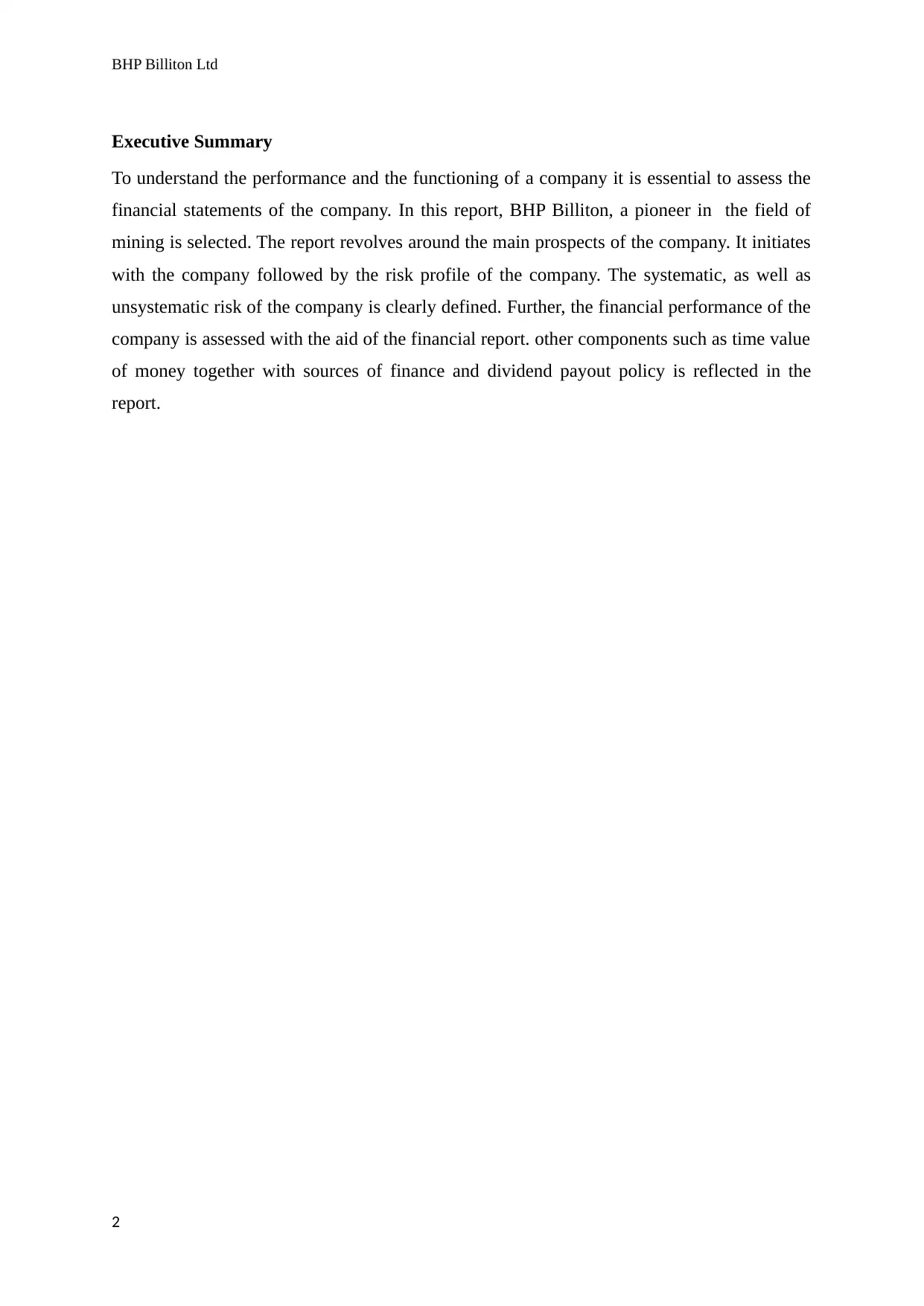
BHP Billiton Ltd
Executive Summary
To understand the performance and the functioning of a company it is essential to assess the
financial statements of the company. In this report, BHP Billiton, a pioneer in the field of
mining is selected. The report revolves around the main prospects of the company. It initiates
with the company followed by the risk profile of the company. The systematic, as well as
unsystematic risk of the company is clearly defined. Further, the financial performance of the
company is assessed with the aid of the financial report. other components such as time value
of money together with sources of finance and dividend payout policy is reflected in the
report.
2
Executive Summary
To understand the performance and the functioning of a company it is essential to assess the
financial statements of the company. In this report, BHP Billiton, a pioneer in the field of
mining is selected. The report revolves around the main prospects of the company. It initiates
with the company followed by the risk profile of the company. The systematic, as well as
unsystematic risk of the company is clearly defined. Further, the financial performance of the
company is assessed with the aid of the financial report. other components such as time value
of money together with sources of finance and dividend payout policy is reflected in the
report.
2
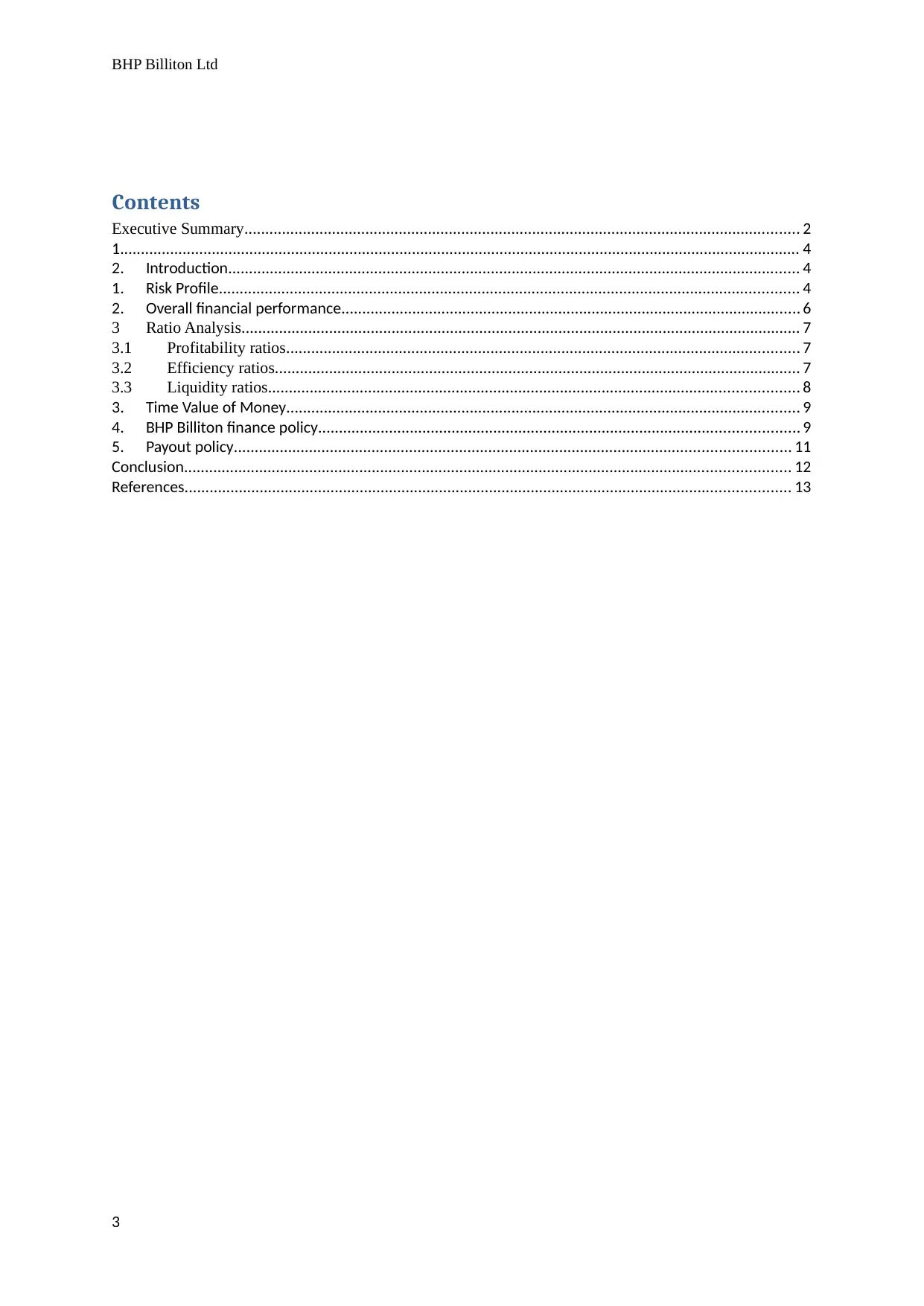
BHP Billiton Ltd
Contents
Executive Summary..................................................................................................................................... 2
1................................................................................................................................................................... 4
2. Introduction......................................................................................................................................... 4
1. Risk Profile........................................................................................................................................... 4
2. Overall financial performance.............................................................................................................. 6
3 Ratio Analysis...................................................................................................................................... 7
3.1 Profitability ratios........................................................................................................................... 7
3.2 Efficiency ratios.............................................................................................................................. 7
3.3 Liquidity ratios............................................................................................................................... 8
3. Time Value of Money........................................................................................................................... 9
4. BHP Billiton finance policy................................................................................................................... 9
5. Payout policy..................................................................................................................................... 11
Conclusion................................................................................................................................................. 12
References................................................................................................................................................. 13
3
Contents
Executive Summary..................................................................................................................................... 2
1................................................................................................................................................................... 4
2. Introduction......................................................................................................................................... 4
1. Risk Profile........................................................................................................................................... 4
2. Overall financial performance.............................................................................................................. 6
3 Ratio Analysis...................................................................................................................................... 7
3.1 Profitability ratios........................................................................................................................... 7
3.2 Efficiency ratios.............................................................................................................................. 7
3.3 Liquidity ratios............................................................................................................................... 8
3. Time Value of Money........................................................................................................................... 9
4. BHP Billiton finance policy................................................................................................................... 9
5. Payout policy..................................................................................................................................... 11
Conclusion................................................................................................................................................. 12
References................................................................................................................................................. 13
3
⊘ This is a preview!⊘
Do you want full access?
Subscribe today to unlock all pages.

Trusted by 1+ million students worldwide
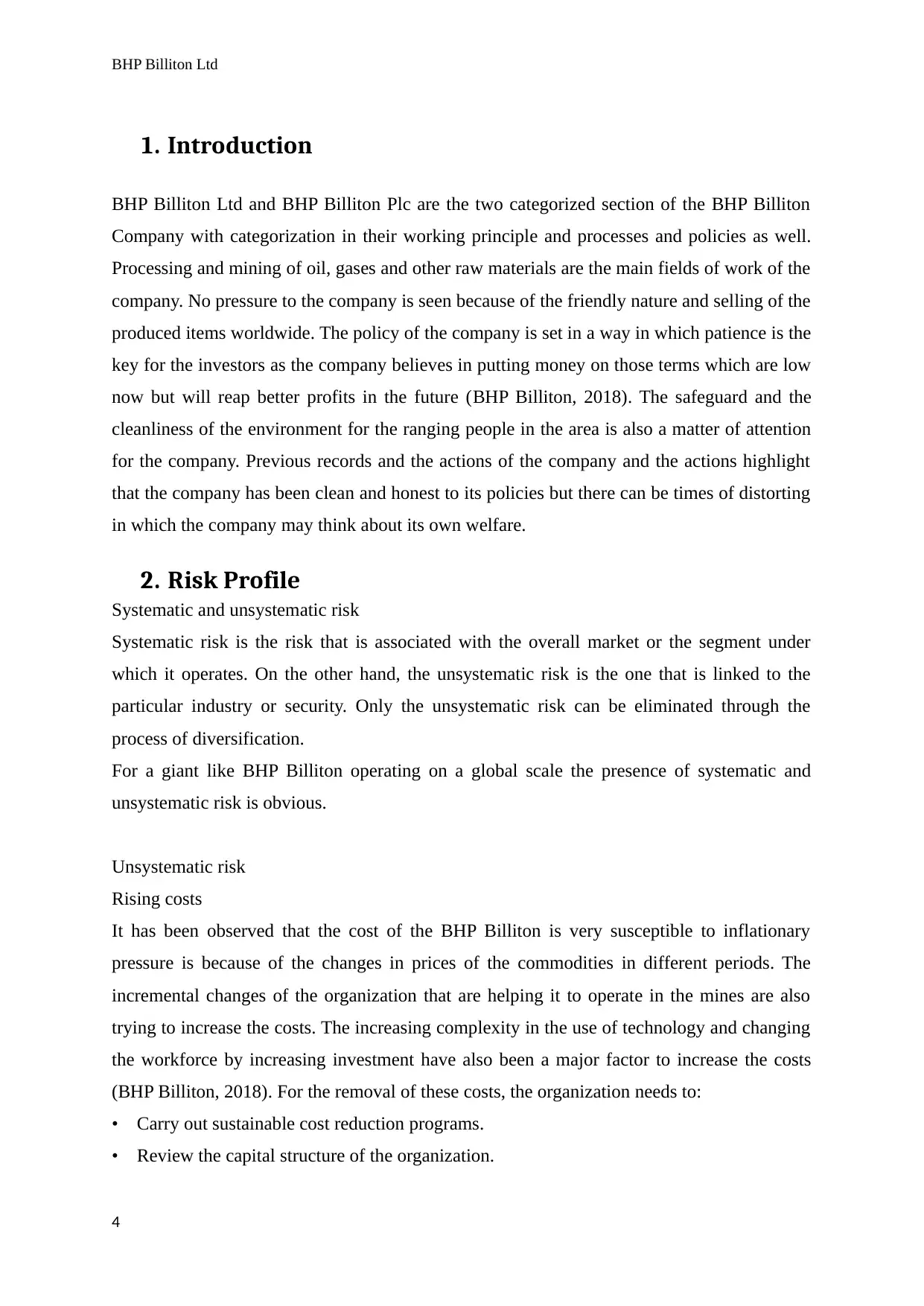
BHP Billiton Ltd
1. Introduction
BHP Billiton Ltd and BHP Billiton Plc are the two categorized section of the BHP Billiton
Company with categorization in their working principle and processes and policies as well.
Processing and mining of oil, gases and other raw materials are the main fields of work of the
company. No pressure to the company is seen because of the friendly nature and selling of the
produced items worldwide. The policy of the company is set in a way in which patience is the
key for the investors as the company believes in putting money on those terms which are low
now but will reap better profits in the future (BHP Billiton, 2018). The safeguard and the
cleanliness of the environment for the ranging people in the area is also a matter of attention
for the company. Previous records and the actions of the company and the actions highlight
that the company has been clean and honest to its policies but there can be times of distorting
in which the company may think about its own welfare.
2. Risk Profile
Systematic and unsystematic risk
Systematic risk is the risk that is associated with the overall market or the segment under
which it operates. On the other hand, the unsystematic risk is the one that is linked to the
particular industry or security. Only the unsystematic risk can be eliminated through the
process of diversification.
For a giant like BHP Billiton operating on a global scale the presence of systematic and
unsystematic risk is obvious.
Unsystematic risk
Rising costs
It has been observed that the cost of the BHP Billiton is very susceptible to inflationary
pressure is because of the changes in prices of the commodities in different periods. The
incremental changes of the organization that are helping it to operate in the mines are also
trying to increase the costs. The increasing complexity in the use of technology and changing
the workforce by increasing investment have also been a major factor to increase the costs
(BHP Billiton, 2018). For the removal of these costs, the organization needs to:
• Carry out sustainable cost reduction programs.
• Review the capital structure of the organization.
4
1. Introduction
BHP Billiton Ltd and BHP Billiton Plc are the two categorized section of the BHP Billiton
Company with categorization in their working principle and processes and policies as well.
Processing and mining of oil, gases and other raw materials are the main fields of work of the
company. No pressure to the company is seen because of the friendly nature and selling of the
produced items worldwide. The policy of the company is set in a way in which patience is the
key for the investors as the company believes in putting money on those terms which are low
now but will reap better profits in the future (BHP Billiton, 2018). The safeguard and the
cleanliness of the environment for the ranging people in the area is also a matter of attention
for the company. Previous records and the actions of the company and the actions highlight
that the company has been clean and honest to its policies but there can be times of distorting
in which the company may think about its own welfare.
2. Risk Profile
Systematic and unsystematic risk
Systematic risk is the risk that is associated with the overall market or the segment under
which it operates. On the other hand, the unsystematic risk is the one that is linked to the
particular industry or security. Only the unsystematic risk can be eliminated through the
process of diversification.
For a giant like BHP Billiton operating on a global scale the presence of systematic and
unsystematic risk is obvious.
Unsystematic risk
Rising costs
It has been observed that the cost of the BHP Billiton is very susceptible to inflationary
pressure is because of the changes in prices of the commodities in different periods. The
incremental changes of the organization that are helping it to operate in the mines are also
trying to increase the costs. The increasing complexity in the use of technology and changing
the workforce by increasing investment have also been a major factor to increase the costs
(BHP Billiton, 2018). For the removal of these costs, the organization needs to:
• Carry out sustainable cost reduction programs.
• Review the capital structure of the organization.
4
Paraphrase This Document
Need a fresh take? Get an instant paraphrase of this document with our AI Paraphraser
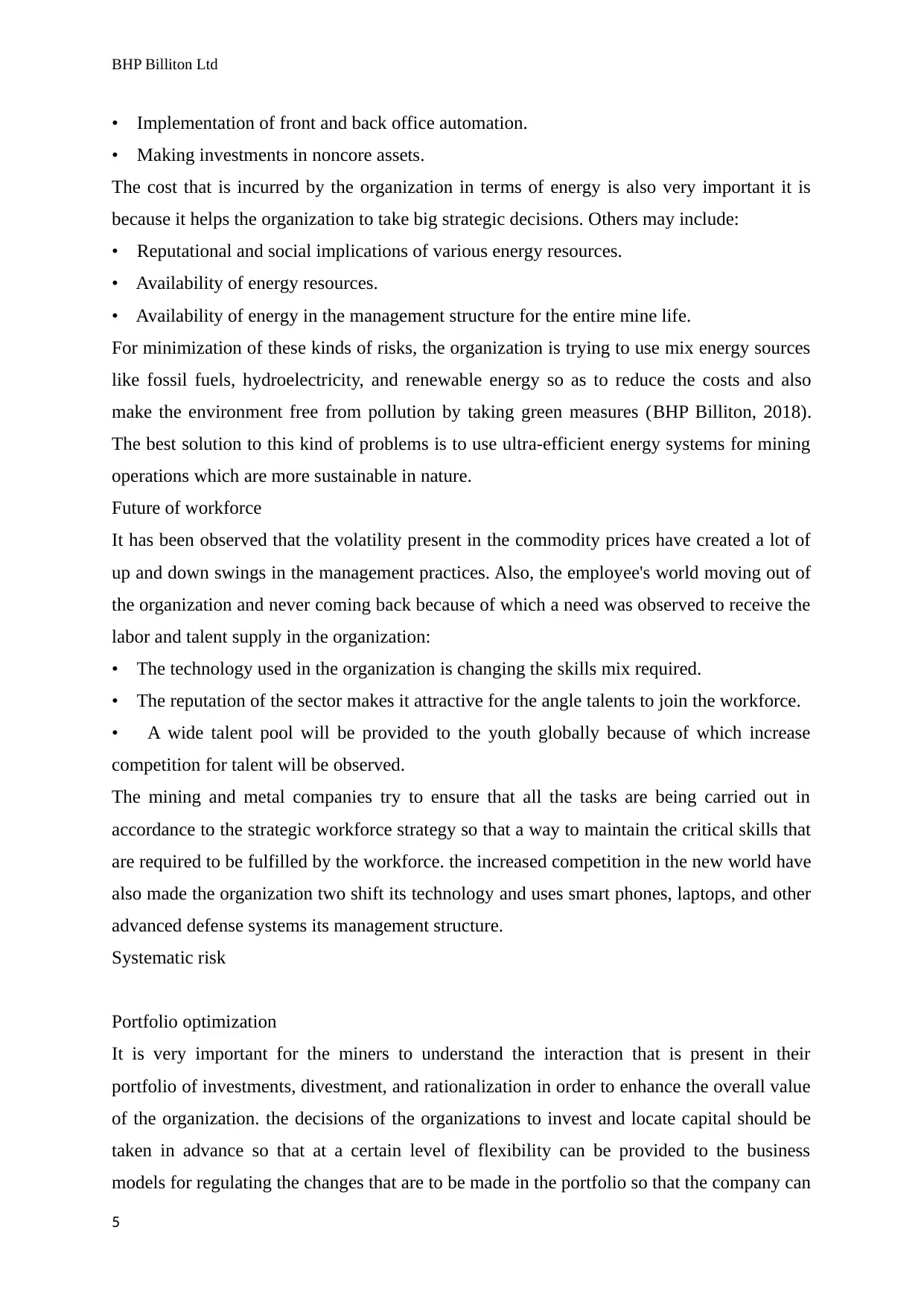
BHP Billiton Ltd
• Implementation of front and back office automation.
• Making investments in noncore assets.
The cost that is incurred by the organization in terms of energy is also very important it is
because it helps the organization to take big strategic decisions. Others may include:
• Reputational and social implications of various energy resources.
• Availability of energy resources.
• Availability of energy in the management structure for the entire mine life.
For minimization of these kinds of risks, the organization is trying to use mix energy sources
like fossil fuels, hydroelectricity, and renewable energy so as to reduce the costs and also
make the environment free from pollution by taking green measures (BHP Billiton, 2018).
The best solution to this kind of problems is to use ultra-efficient energy systems for mining
operations which are more sustainable in nature.
Future of workforce
It has been observed that the volatility present in the commodity prices have created a lot of
up and down swings in the management practices. Also, the employee's world moving out of
the organization and never coming back because of which a need was observed to receive the
labor and talent supply in the organization:
• The technology used in the organization is changing the skills mix required.
• The reputation of the sector makes it attractive for the angle talents to join the workforce.
• A wide talent pool will be provided to the youth globally because of which increase
competition for talent will be observed.
The mining and metal companies try to ensure that all the tasks are being carried out in
accordance to the strategic workforce strategy so that a way to maintain the critical skills that
are required to be fulfilled by the workforce. the increased competition in the new world have
also made the organization two shift its technology and uses smart phones, laptops, and other
advanced defense systems its management structure.
Systematic risk
Portfolio optimization
It is very important for the miners to understand the interaction that is present in their
portfolio of investments, divestment, and rationalization in order to enhance the overall value
of the organization. the decisions of the organizations to invest and locate capital should be
taken in advance so that at a certain level of flexibility can be provided to the business
models for regulating the changes that are to be made in the portfolio so that the company can
5
• Implementation of front and back office automation.
• Making investments in noncore assets.
The cost that is incurred by the organization in terms of energy is also very important it is
because it helps the organization to take big strategic decisions. Others may include:
• Reputational and social implications of various energy resources.
• Availability of energy resources.
• Availability of energy in the management structure for the entire mine life.
For minimization of these kinds of risks, the organization is trying to use mix energy sources
like fossil fuels, hydroelectricity, and renewable energy so as to reduce the costs and also
make the environment free from pollution by taking green measures (BHP Billiton, 2018).
The best solution to this kind of problems is to use ultra-efficient energy systems for mining
operations which are more sustainable in nature.
Future of workforce
It has been observed that the volatility present in the commodity prices have created a lot of
up and down swings in the management practices. Also, the employee's world moving out of
the organization and never coming back because of which a need was observed to receive the
labor and talent supply in the organization:
• The technology used in the organization is changing the skills mix required.
• The reputation of the sector makes it attractive for the angle talents to join the workforce.
• A wide talent pool will be provided to the youth globally because of which increase
competition for talent will be observed.
The mining and metal companies try to ensure that all the tasks are being carried out in
accordance to the strategic workforce strategy so that a way to maintain the critical skills that
are required to be fulfilled by the workforce. the increased competition in the new world have
also made the organization two shift its technology and uses smart phones, laptops, and other
advanced defense systems its management structure.
Systematic risk
Portfolio optimization
It is very important for the miners to understand the interaction that is present in their
portfolio of investments, divestment, and rationalization in order to enhance the overall value
of the organization. the decisions of the organizations to invest and locate capital should be
taken in advance so that at a certain level of flexibility can be provided to the business
models for regulating the changes that are to be made in the portfolio so that the company can
5
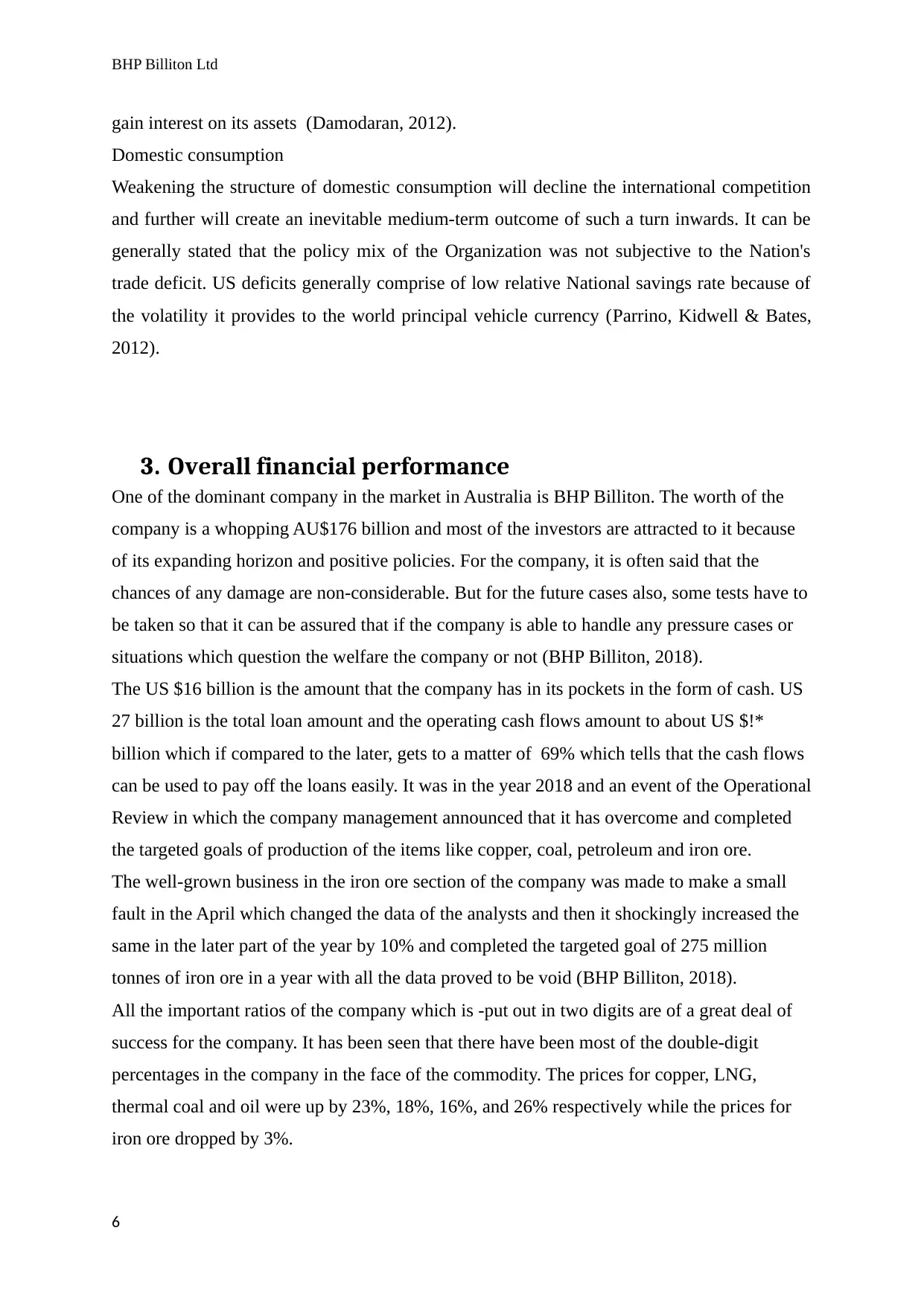
BHP Billiton Ltd
gain interest on its assets (Damodaran, 2012).
Domestic consumption
Weakening the structure of domestic consumption will decline the international competition
and further will create an inevitable medium-term outcome of such a turn inwards. It can be
generally stated that the policy mix of the Organization was not subjective to the Nation's
trade deficit. US deficits generally comprise of low relative National savings rate because of
the volatility it provides to the world principal vehicle currency (Parrino, Kidwell & Bates,
2012).
3. Overall financial performance
One of the dominant company in the market in Australia is BHP Billiton. The worth of the
company is a whopping AU$176 billion and most of the investors are attracted to it because
of its expanding horizon and positive policies. For the company, it is often said that the
chances of any damage are non-considerable. But for the future cases also, some tests have to
be taken so that it can be assured that if the company is able to handle any pressure cases or
situations which question the welfare the company or not (BHP Billiton, 2018).
The US $16 billion is the amount that the company has in its pockets in the form of cash. US
27 billion is the total loan amount and the operating cash flows amount to about US $!*
billion which if compared to the later, gets to a matter of 69% which tells that the cash flows
can be used to pay off the loans easily. It was in the year 2018 and an event of the Operational
Review in which the company management announced that it has overcome and completed
the targeted goals of production of the items like copper, coal, petroleum and iron ore.
The well-grown business in the iron ore section of the company was made to make a small
fault in the April which changed the data of the analysts and then it shockingly increased the
same in the later part of the year by 10% and completed the targeted goal of 275 million
tonnes of iron ore in a year with all the data proved to be void (BHP Billiton, 2018).
All the important ratios of the company which is -put out in two digits are of a great deal of
success for the company. It has been seen that there have been most of the double-digit
percentages in the company in the face of the commodity. The prices for copper, LNG,
thermal coal and oil were up by 23%, 18%, 16%, and 26% respectively while the prices for
iron ore dropped by 3%.
6
gain interest on its assets (Damodaran, 2012).
Domestic consumption
Weakening the structure of domestic consumption will decline the international competition
and further will create an inevitable medium-term outcome of such a turn inwards. It can be
generally stated that the policy mix of the Organization was not subjective to the Nation's
trade deficit. US deficits generally comprise of low relative National savings rate because of
the volatility it provides to the world principal vehicle currency (Parrino, Kidwell & Bates,
2012).
3. Overall financial performance
One of the dominant company in the market in Australia is BHP Billiton. The worth of the
company is a whopping AU$176 billion and most of the investors are attracted to it because
of its expanding horizon and positive policies. For the company, it is often said that the
chances of any damage are non-considerable. But for the future cases also, some tests have to
be taken so that it can be assured that if the company is able to handle any pressure cases or
situations which question the welfare the company or not (BHP Billiton, 2018).
The US $16 billion is the amount that the company has in its pockets in the form of cash. US
27 billion is the total loan amount and the operating cash flows amount to about US $!*
billion which if compared to the later, gets to a matter of 69% which tells that the cash flows
can be used to pay off the loans easily. It was in the year 2018 and an event of the Operational
Review in which the company management announced that it has overcome and completed
the targeted goals of production of the items like copper, coal, petroleum and iron ore.
The well-grown business in the iron ore section of the company was made to make a small
fault in the April which changed the data of the analysts and then it shockingly increased the
same in the later part of the year by 10% and completed the targeted goal of 275 million
tonnes of iron ore in a year with all the data proved to be void (BHP Billiton, 2018).
All the important ratios of the company which is -put out in two digits are of a great deal of
success for the company. It has been seen that there have been most of the double-digit
percentages in the company in the face of the commodity. The prices for copper, LNG,
thermal coal and oil were up by 23%, 18%, 16%, and 26% respectively while the prices for
iron ore dropped by 3%.
6
⊘ This is a preview!⊘
Do you want full access?
Subscribe today to unlock all pages.

Trusted by 1+ million students worldwide
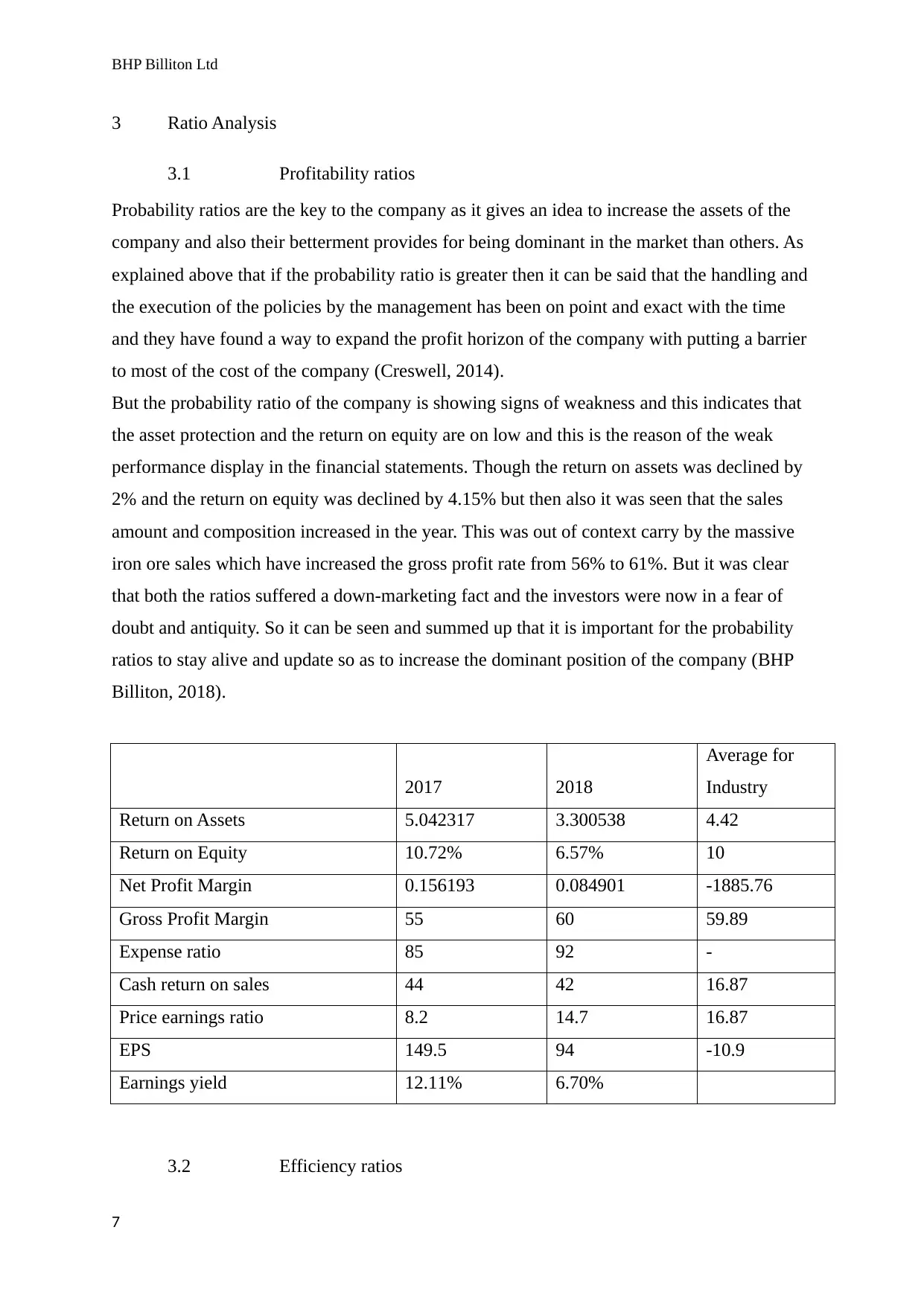
BHP Billiton Ltd
3 Ratio Analysis
3.1 Profitability ratios
Probability ratios are the key to the company as it gives an idea to increase the assets of the
company and also their betterment provides for being dominant in the market than others. As
explained above that if the probability ratio is greater then it can be said that the handling and
the execution of the policies by the management has been on point and exact with the time
and they have found a way to expand the profit horizon of the company with putting a barrier
to most of the cost of the company (Creswell, 2014).
But the probability ratio of the company is showing signs of weakness and this indicates that
the asset protection and the return on equity are on low and this is the reason of the weak
performance display in the financial statements. Though the return on assets was declined by
2% and the return on equity was declined by 4.15% but then also it was seen that the sales
amount and composition increased in the year. This was out of context carry by the massive
iron ore sales which have increased the gross profit rate from 56% to 61%. But it was clear
that both the ratios suffered a down-marketing fact and the investors were now in a fear of
doubt and antiquity. So it can be seen and summed up that it is important for the probability
ratios to stay alive and update so as to increase the dominant position of the company (BHP
Billiton, 2018).
2017 2018
Average for
Industry
Return on Assets 5.042317 3.300538 4.42
Return on Equity 10.72% 6.57% 10
Net Profit Margin 0.156193 0.084901 -1885.76
Gross Profit Margin 55 60 59.89
Expense ratio 85 92 -
Cash return on sales 44 42 16.87
Price earnings ratio 8.2 14.7 16.87
EPS 149.5 94 -10.9
Earnings yield 12.11% 6.70%
3.2 Efficiency ratios
7
3 Ratio Analysis
3.1 Profitability ratios
Probability ratios are the key to the company as it gives an idea to increase the assets of the
company and also their betterment provides for being dominant in the market than others. As
explained above that if the probability ratio is greater then it can be said that the handling and
the execution of the policies by the management has been on point and exact with the time
and they have found a way to expand the profit horizon of the company with putting a barrier
to most of the cost of the company (Creswell, 2014).
But the probability ratio of the company is showing signs of weakness and this indicates that
the asset protection and the return on equity are on low and this is the reason of the weak
performance display in the financial statements. Though the return on assets was declined by
2% and the return on equity was declined by 4.15% but then also it was seen that the sales
amount and composition increased in the year. This was out of context carry by the massive
iron ore sales which have increased the gross profit rate from 56% to 61%. But it was clear
that both the ratios suffered a down-marketing fact and the investors were now in a fear of
doubt and antiquity. So it can be seen and summed up that it is important for the probability
ratios to stay alive and update so as to increase the dominant position of the company (BHP
Billiton, 2018).
2017 2018
Average for
Industry
Return on Assets 5.042317 3.300538 4.42
Return on Equity 10.72% 6.57% 10
Net Profit Margin 0.156193 0.084901 -1885.76
Gross Profit Margin 55 60 59.89
Expense ratio 85 92 -
Cash return on sales 44 42 16.87
Price earnings ratio 8.2 14.7 16.87
EPS 149.5 94 -10.9
Earnings yield 12.11% 6.70%
3.2 Efficiency ratios
7
Paraphrase This Document
Need a fresh take? Get an instant paraphrase of this document with our AI Paraphraser
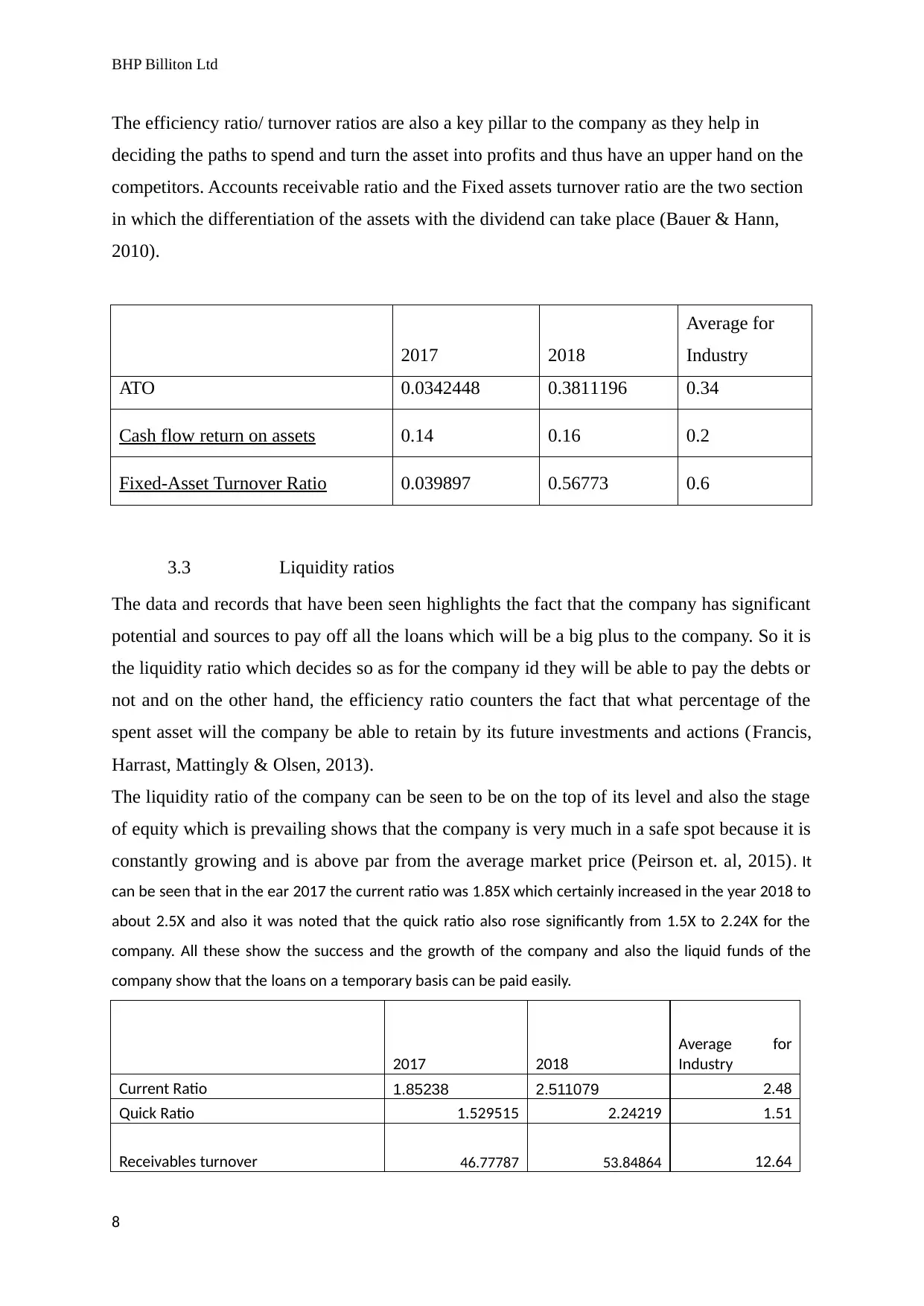
BHP Billiton Ltd
The efficiency ratio/ turnover ratios are also a key pillar to the company as they help in
deciding the paths to spend and turn the asset into profits and thus have an upper hand on the
competitors. Accounts receivable ratio and the Fixed assets turnover ratio are the two section
in which the differentiation of the assets with the dividend can take place (Bauer & Hann,
2010).
2017 2018
Average for
Industry
ATO 0.0342448 0.3811196 0.34
Cash flow return on assets 0.14 0.16 0.2
Fixed-Asset Turnover Ratio 0.039897 0.56773 0.6
3.3 Liquidity ratios
The data and records that have been seen highlights the fact that the company has significant
potential and sources to pay off all the loans which will be a big plus to the company. So it is
the liquidity ratio which decides so as for the company id they will be able to pay the debts or
not and on the other hand, the efficiency ratio counters the fact that what percentage of the
spent asset will the company be able to retain by its future investments and actions (Francis,
Harrast, Mattingly & Olsen, 2013).
The liquidity ratio of the company can be seen to be on the top of its level and also the stage
of equity which is prevailing shows that the company is very much in a safe spot because it is
constantly growing and is above par from the average market price (Peirson et. al, 2015). It
can be seen that in the ear 2017 the current ratio was 1.85X which certainly increased in the year 2018 to
about 2.5X and also it was noted that the quick ratio also rose significantly from 1.5X to 2.24X for the
company. All these show the success and the growth of the company and also the liquid funds of the
company show that the loans on a temporary basis can be paid easily.
2017 2018
Average for
Industry
Current Ratio 1.85238 2.511079 2.48
Quick Ratio 1.529515 2.24219 1.51
Receivables turnover 46.77787 53.84864 12.64
8
The efficiency ratio/ turnover ratios are also a key pillar to the company as they help in
deciding the paths to spend and turn the asset into profits and thus have an upper hand on the
competitors. Accounts receivable ratio and the Fixed assets turnover ratio are the two section
in which the differentiation of the assets with the dividend can take place (Bauer & Hann,
2010).
2017 2018
Average for
Industry
ATO 0.0342448 0.3811196 0.34
Cash flow return on assets 0.14 0.16 0.2
Fixed-Asset Turnover Ratio 0.039897 0.56773 0.6
3.3 Liquidity ratios
The data and records that have been seen highlights the fact that the company has significant
potential and sources to pay off all the loans which will be a big plus to the company. So it is
the liquidity ratio which decides so as for the company id they will be able to pay the debts or
not and on the other hand, the efficiency ratio counters the fact that what percentage of the
spent asset will the company be able to retain by its future investments and actions (Francis,
Harrast, Mattingly & Olsen, 2013).
The liquidity ratio of the company can be seen to be on the top of its level and also the stage
of equity which is prevailing shows that the company is very much in a safe spot because it is
constantly growing and is above par from the average market price (Peirson et. al, 2015). It
can be seen that in the ear 2017 the current ratio was 1.85X which certainly increased in the year 2018 to
about 2.5X and also it was noted that the quick ratio also rose significantly from 1.5X to 2.24X for the
company. All these show the success and the growth of the company and also the liquid funds of the
company show that the loans on a temporary basis can be paid easily.
2017 2018
Average for
Industry
Current Ratio 1.85238 2.511079 2.48
Quick Ratio 1.529515 2.24219 1.51
Receivables turnover 46.77787 53.84864 12.64
8
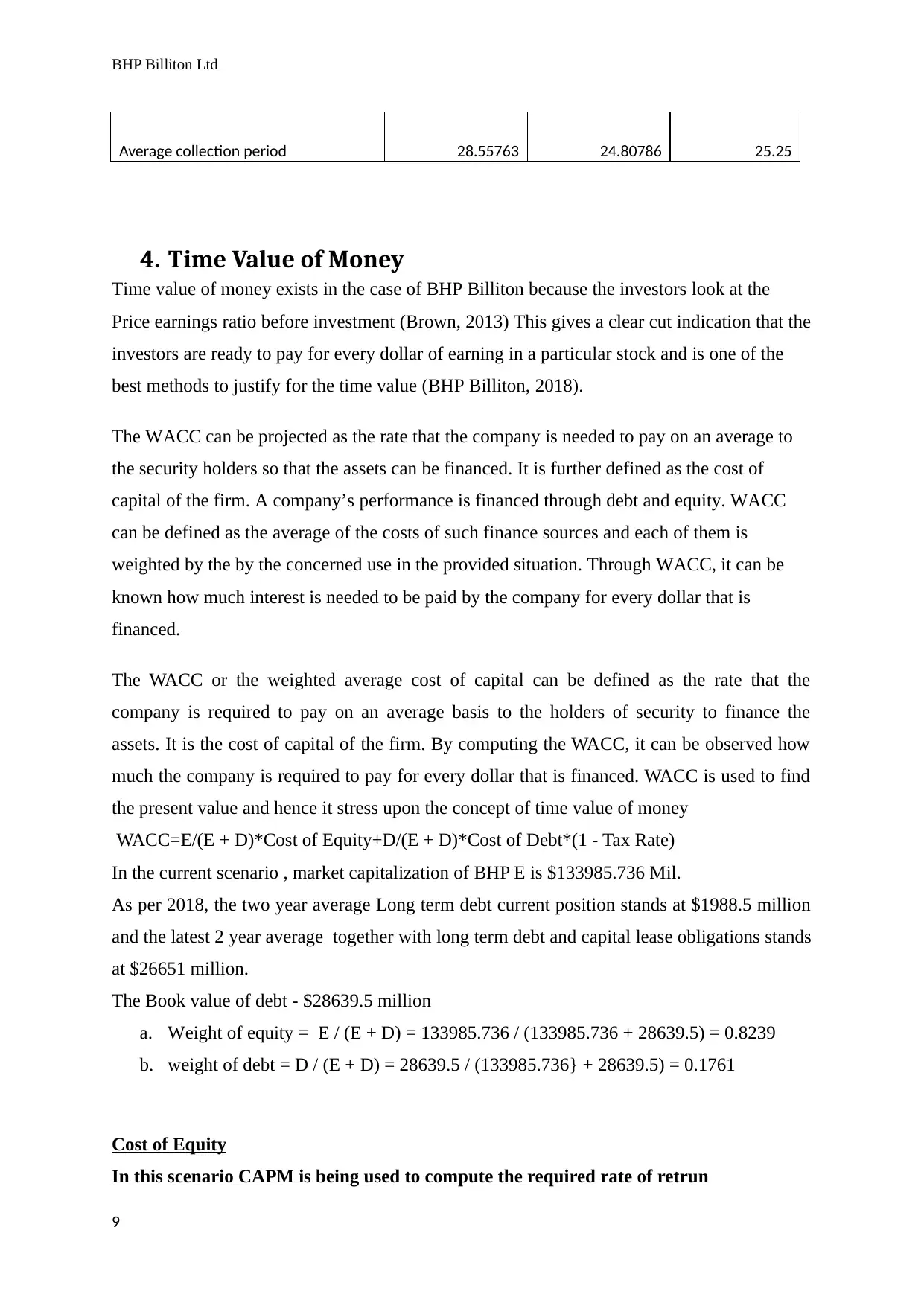
BHP Billiton Ltd
Average collection period 28.55763 24.80786 25.25
4. Time Value of Money
Time value of money exists in the case of BHP Billiton because the investors look at the
Price earnings ratio before investment (Brown, 2013) This gives a clear cut indication that the
investors are ready to pay for every dollar of earning in a particular stock and is one of the
best methods to justify for the time value (BHP Billiton, 2018).
The WACC can be projected as the rate that the company is needed to pay on an average to
the security holders so that the assets can be financed. It is further defined as the cost of
capital of the firm. A company’s performance is financed through debt and equity. WACC
can be defined as the average of the costs of such finance sources and each of them is
weighted by the by the concerned use in the provided situation. Through WACC, it can be
known how much interest is needed to be paid by the company for every dollar that is
financed.
The WACC or the weighted average cost of capital can be defined as the rate that the
company is required to pay on an average basis to the holders of security to finance the
assets. It is the cost of capital of the firm. By computing the WACC, it can be observed how
much the company is required to pay for every dollar that is financed. WACC is used to find
the present value and hence it stress upon the concept of time value of money
WACC=E/(E + D)*Cost of Equity+D/(E + D)*Cost of Debt*(1 - Tax Rate)
In the current scenario , market capitalization of BHP E is $133985.736 Mil.
As per 2018, the two year average Long term debt current position stands at $1988.5 million
and the latest 2 year average together with long term debt and capital lease obligations stands
at $26651 million.
The Book value of debt - $28639.5 million
a. Weight of equity = E / (E + D) = 133985.736 / (133985.736 + 28639.5) = 0.8239
b. weight of debt = D / (E + D) = 28639.5 / (133985.736} + 28639.5) = 0.1761
Cost of Equity
In this scenario CAPM is being used to compute the required rate of retrun
9
Average collection period 28.55763 24.80786 25.25
4. Time Value of Money
Time value of money exists in the case of BHP Billiton because the investors look at the
Price earnings ratio before investment (Brown, 2013) This gives a clear cut indication that the
investors are ready to pay for every dollar of earning in a particular stock and is one of the
best methods to justify for the time value (BHP Billiton, 2018).
The WACC can be projected as the rate that the company is needed to pay on an average to
the security holders so that the assets can be financed. It is further defined as the cost of
capital of the firm. A company’s performance is financed through debt and equity. WACC
can be defined as the average of the costs of such finance sources and each of them is
weighted by the by the concerned use in the provided situation. Through WACC, it can be
known how much interest is needed to be paid by the company for every dollar that is
financed.
The WACC or the weighted average cost of capital can be defined as the rate that the
company is required to pay on an average basis to the holders of security to finance the
assets. It is the cost of capital of the firm. By computing the WACC, it can be observed how
much the company is required to pay for every dollar that is financed. WACC is used to find
the present value and hence it stress upon the concept of time value of money
WACC=E/(E + D)*Cost of Equity+D/(E + D)*Cost of Debt*(1 - Tax Rate)
In the current scenario , market capitalization of BHP E is $133985.736 Mil.
As per 2018, the two year average Long term debt current position stands at $1988.5 million
and the latest 2 year average together with long term debt and capital lease obligations stands
at $26651 million.
The Book value of debt - $28639.5 million
a. Weight of equity = E / (E + D) = 133985.736 / (133985.736 + 28639.5) = 0.8239
b. weight of debt = D / (E + D) = 28639.5 / (133985.736} + 28639.5) = 0.1761
Cost of Equity
In this scenario CAPM is being used to compute the required rate of retrun
9
⊘ This is a preview!⊘
Do you want full access?
Subscribe today to unlock all pages.

Trusted by 1+ million students worldwide

BHP Billiton Ltd
The formula stands at Cost of Equity = Risk-Free Rate of Return + Asset beta * (Expected
Return of the Market - Risk-Free Rate of Return)
Risk free rate – 1.96%
The beta of BHP group is 0.24
Market premium stands at 6%
Cost of equity = 1.96% + 0.24*6% = 3.4%
Cost of debt
Till June 2018, the interest expense of BHP stood at $1088 million. On the other hand the
Book value of debt is $28639.5 million
Cost of debt = 1088 / 28639.5 = 3.7%.
The tax rate of last two years stands at 43.695%
WACC of BHP
WACC=E/(E + D)*Cost of Equity + D/(E + D)*Cost of Debt*(1 - Tax Rate)
= 0.839 * 3.4% + 0.1761 * 3.7% * (1-43.69%)
= 3.18%
Raising capital involves money. BHP generates higher return on investment that the company
needs so that capital can be raised for the investment. Hence, it is able to reap excess return.
Cash can be defined as the FV and WACC is needed to do the PV hence indicates financial
situation is influenced by the time value of money.
5. BHP Billiton finance policy
It has been observed that the BHP Billiton organization have tried to reduce its debt from
36.1 3 billion dollars to 28.45 billion dollars which have helped it to provide stability to the
current and long term debts. After repayment of all the debts, the total cash that can be
invested into the business was started at 12.34 billion dollars. Additional, it was observed that
the organization was producing more than 16.45 billion dollars as operating cash flow. This
helped the organization to maintain a total debt ratio of 57.8 2% which states that BHP
Billiton can cover almost all the debts by the help of the operating cash (Market index, 2018).
Also, BHP Billiton is able to generate 0.58X cash with the help of the debt capital that has
been collected by it. The ratio is also used to determine the measure of efficiency in
10
The formula stands at Cost of Equity = Risk-Free Rate of Return + Asset beta * (Expected
Return of the Market - Risk-Free Rate of Return)
Risk free rate – 1.96%
The beta of BHP group is 0.24
Market premium stands at 6%
Cost of equity = 1.96% + 0.24*6% = 3.4%
Cost of debt
Till June 2018, the interest expense of BHP stood at $1088 million. On the other hand the
Book value of debt is $28639.5 million
Cost of debt = 1088 / 28639.5 = 3.7%.
The tax rate of last two years stands at 43.695%
WACC of BHP
WACC=E/(E + D)*Cost of Equity + D/(E + D)*Cost of Debt*(1 - Tax Rate)
= 0.839 * 3.4% + 0.1761 * 3.7% * (1-43.69%)
= 3.18%
Raising capital involves money. BHP generates higher return on investment that the company
needs so that capital can be raised for the investment. Hence, it is able to reap excess return.
Cash can be defined as the FV and WACC is needed to do the PV hence indicates financial
situation is influenced by the time value of money.
5. BHP Billiton finance policy
It has been observed that the BHP Billiton organization have tried to reduce its debt from
36.1 3 billion dollars to 28.45 billion dollars which have helped it to provide stability to the
current and long term debts. After repayment of all the debts, the total cash that can be
invested into the business was started at 12.34 billion dollars. Additional, it was observed that
the organization was producing more than 16.45 billion dollars as operating cash flow. This
helped the organization to maintain a total debt ratio of 57.8 2% which states that BHP
Billiton can cover almost all the debts by the help of the operating cash (Market index, 2018).
Also, BHP Billiton is able to generate 0.58X cash with the help of the debt capital that has
been collected by it. The ratio is also used to determine the measure of efficiency in
10
Paraphrase This Document
Need a fresh take? Get an instant paraphrase of this document with our AI Paraphraser
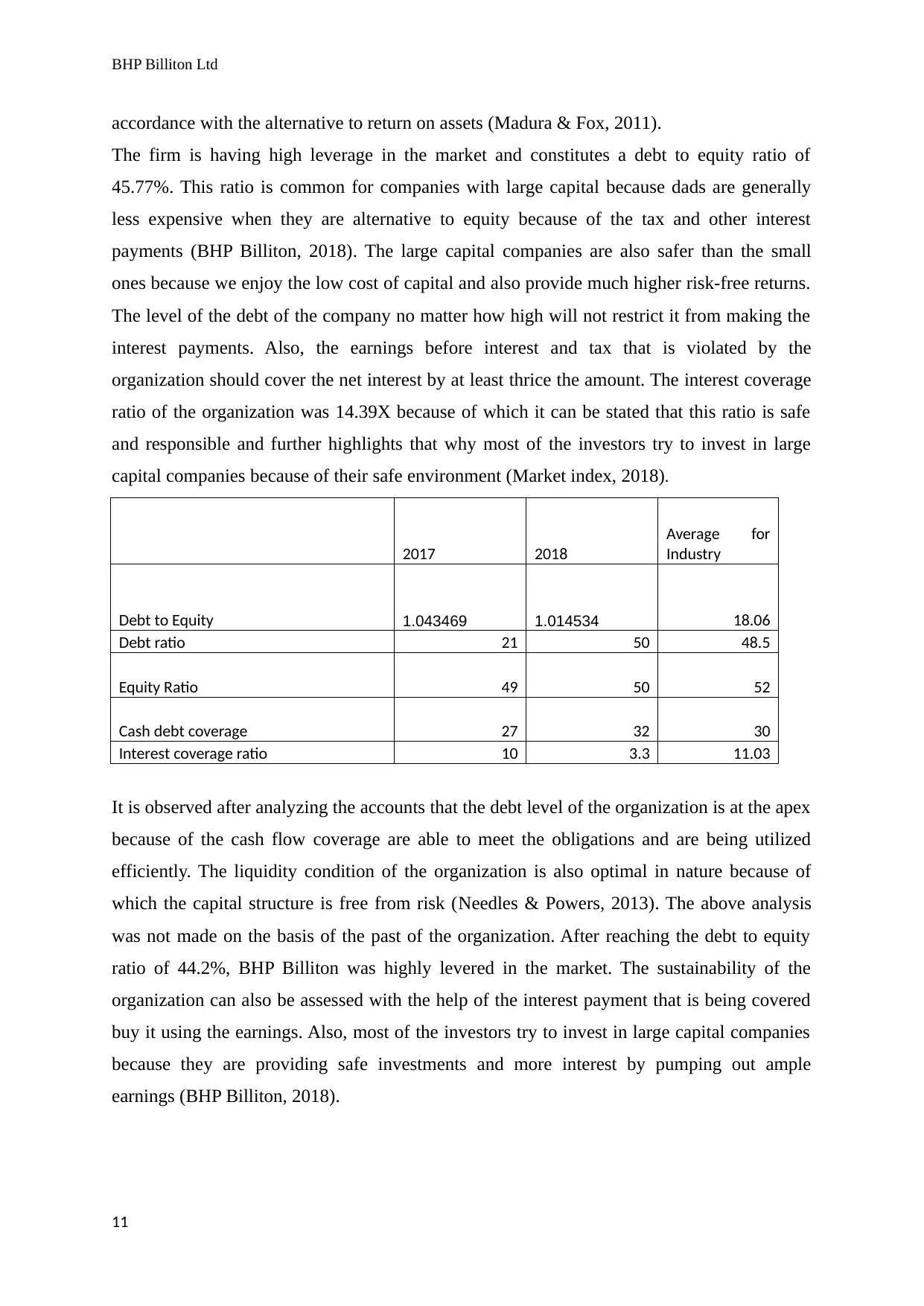
BHP Billiton Ltd
accordance with the alternative to return on assets (Madura & Fox, 2011).
The firm is having high leverage in the market and constitutes a debt to equity ratio of
45.77%. This ratio is common for companies with large capital because dads are generally
less expensive when they are alternative to equity because of the tax and other interest
payments (BHP Billiton, 2018). The large capital companies are also safer than the small
ones because we enjoy the low cost of capital and also provide much higher risk-free returns.
The level of the debt of the company no matter how high will not restrict it from making the
interest payments. Also, the earnings before interest and tax that is violated by the
organization should cover the net interest by at least thrice the amount. The interest coverage
ratio of the organization was 14.39X because of which it can be stated that this ratio is safe
and responsible and further highlights that why most of the investors try to invest in large
capital companies because of their safe environment (Market index, 2018).
2017 2018
Average for
Industry
Debt to Equity 1.043469 1.014534 18.06
Debt ratio 21 50 48.5
Equity Ratio 49 50 52
Cash debt coverage 27 32 30
Interest coverage ratio 10 3.3 11.03
It is observed after analyzing the accounts that the debt level of the organization is at the apex
because of the cash flow coverage are able to meet the obligations and are being utilized
efficiently. The liquidity condition of the organization is also optimal in nature because of
which the capital structure is free from risk (Needles & Powers, 2013). The above analysis
was not made on the basis of the past of the organization. After reaching the debt to equity
ratio of 44.2%, BHP Billiton was highly levered in the market. The sustainability of the
organization can also be assessed with the help of the interest payment that is being covered
buy it using the earnings. Also, most of the investors try to invest in large capital companies
because they are providing safe investments and more interest by pumping out ample
earnings (BHP Billiton, 2018).
11
accordance with the alternative to return on assets (Madura & Fox, 2011).
The firm is having high leverage in the market and constitutes a debt to equity ratio of
45.77%. This ratio is common for companies with large capital because dads are generally
less expensive when they are alternative to equity because of the tax and other interest
payments (BHP Billiton, 2018). The large capital companies are also safer than the small
ones because we enjoy the low cost of capital and also provide much higher risk-free returns.
The level of the debt of the company no matter how high will not restrict it from making the
interest payments. Also, the earnings before interest and tax that is violated by the
organization should cover the net interest by at least thrice the amount. The interest coverage
ratio of the organization was 14.39X because of which it can be stated that this ratio is safe
and responsible and further highlights that why most of the investors try to invest in large
capital companies because of their safe environment (Market index, 2018).
2017 2018
Average for
Industry
Debt to Equity 1.043469 1.014534 18.06
Debt ratio 21 50 48.5
Equity Ratio 49 50 52
Cash debt coverage 27 32 30
Interest coverage ratio 10 3.3 11.03
It is observed after analyzing the accounts that the debt level of the organization is at the apex
because of the cash flow coverage are able to meet the obligations and are being utilized
efficiently. The liquidity condition of the organization is also optimal in nature because of
which the capital structure is free from risk (Needles & Powers, 2013). The above analysis
was not made on the basis of the past of the organization. After reaching the debt to equity
ratio of 44.2%, BHP Billiton was highly levered in the market. The sustainability of the
organization can also be assessed with the help of the interest payment that is being covered
buy it using the earnings. Also, most of the investors try to invest in large capital companies
because they are providing safe investments and more interest by pumping out ample
earnings (BHP Billiton, 2018).
11
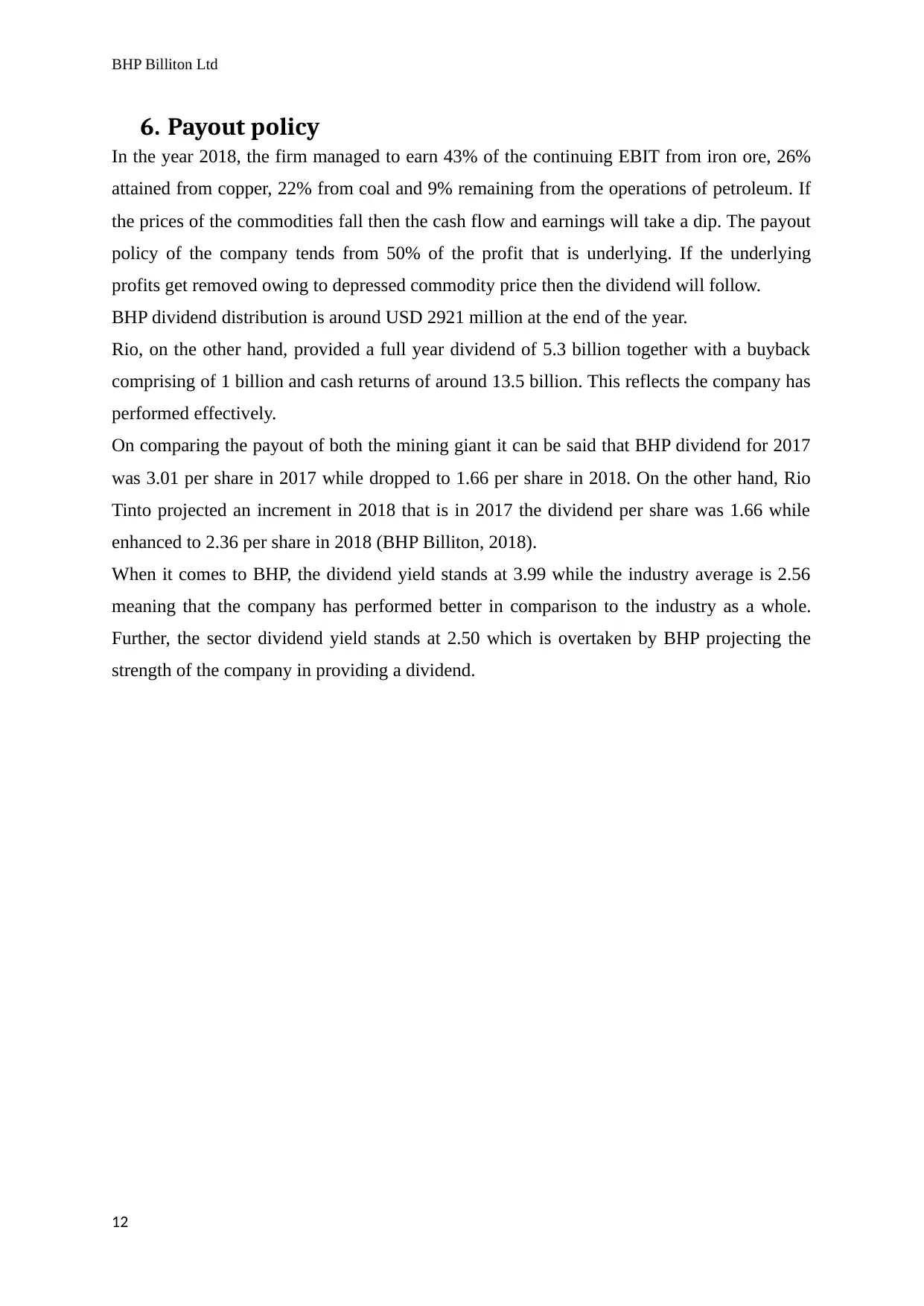
BHP Billiton Ltd
6. Payout policy
In the year 2018, the firm managed to earn 43% of the continuing EBIT from iron ore, 26%
attained from copper, 22% from coal and 9% remaining from the operations of petroleum. If
the prices of the commodities fall then the cash flow and earnings will take a dip. The payout
policy of the company tends from 50% of the profit that is underlying. If the underlying
profits get removed owing to depressed commodity price then the dividend will follow.
BHP dividend distribution is around USD 2921 million at the end of the year.
Rio, on the other hand, provided a full year dividend of 5.3 billion together with a buyback
comprising of 1 billion and cash returns of around 13.5 billion. This reflects the company has
performed effectively.
On comparing the payout of both the mining giant it can be said that BHP dividend for 2017
was 3.01 per share in 2017 while dropped to 1.66 per share in 2018. On the other hand, Rio
Tinto projected an increment in 2018 that is in 2017 the dividend per share was 1.66 while
enhanced to 2.36 per share in 2018 (BHP Billiton, 2018).
When it comes to BHP, the dividend yield stands at 3.99 while the industry average is 2.56
meaning that the company has performed better in comparison to the industry as a whole.
Further, the sector dividend yield stands at 2.50 which is overtaken by BHP projecting the
strength of the company in providing a dividend.
12
6. Payout policy
In the year 2018, the firm managed to earn 43% of the continuing EBIT from iron ore, 26%
attained from copper, 22% from coal and 9% remaining from the operations of petroleum. If
the prices of the commodities fall then the cash flow and earnings will take a dip. The payout
policy of the company tends from 50% of the profit that is underlying. If the underlying
profits get removed owing to depressed commodity price then the dividend will follow.
BHP dividend distribution is around USD 2921 million at the end of the year.
Rio, on the other hand, provided a full year dividend of 5.3 billion together with a buyback
comprising of 1 billion and cash returns of around 13.5 billion. This reflects the company has
performed effectively.
On comparing the payout of both the mining giant it can be said that BHP dividend for 2017
was 3.01 per share in 2017 while dropped to 1.66 per share in 2018. On the other hand, Rio
Tinto projected an increment in 2018 that is in 2017 the dividend per share was 1.66 while
enhanced to 2.36 per share in 2018 (BHP Billiton, 2018).
When it comes to BHP, the dividend yield stands at 3.99 while the industry average is 2.56
meaning that the company has performed better in comparison to the industry as a whole.
Further, the sector dividend yield stands at 2.50 which is overtaken by BHP projecting the
strength of the company in providing a dividend.
12
⊘ This is a preview!⊘
Do you want full access?
Subscribe today to unlock all pages.

Trusted by 1+ million students worldwide
1 out of 15
Related Documents
Your All-in-One AI-Powered Toolkit for Academic Success.
+13062052269
info@desklib.com
Available 24*7 on WhatsApp / Email
![[object Object]](/_next/static/media/star-bottom.7253800d.svg)
Unlock your academic potential
Copyright © 2020–2025 A2Z Services. All Rights Reserved. Developed and managed by ZUCOL.





